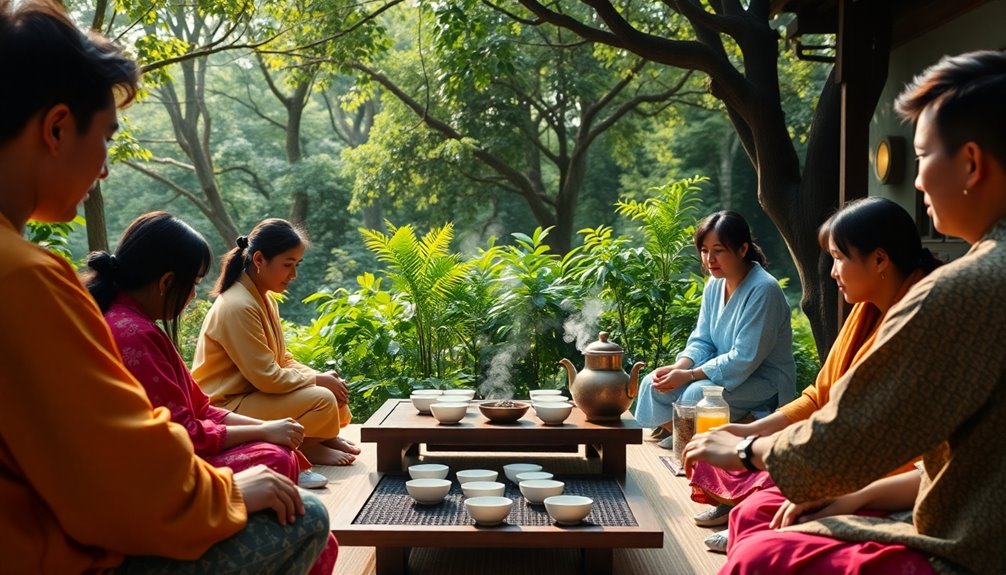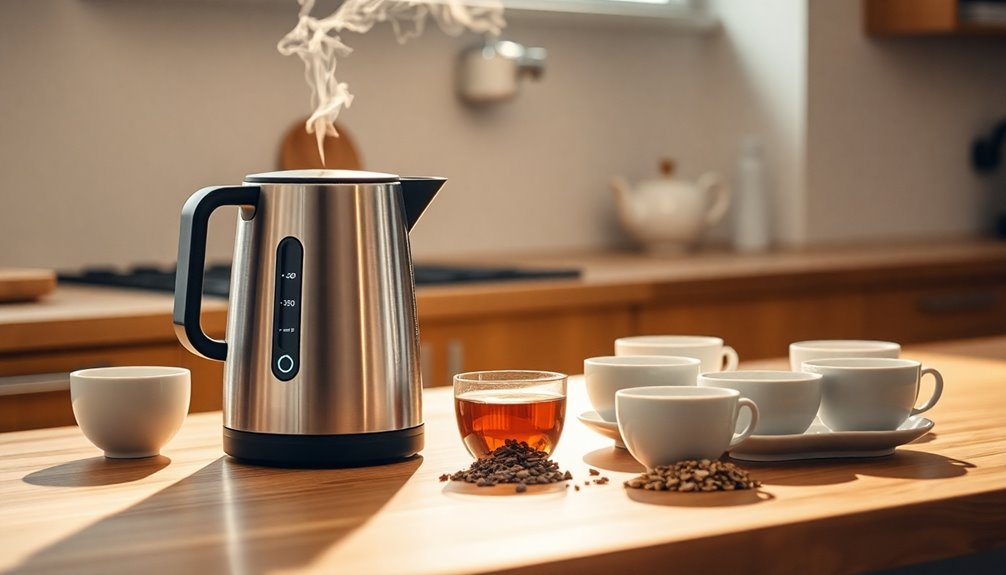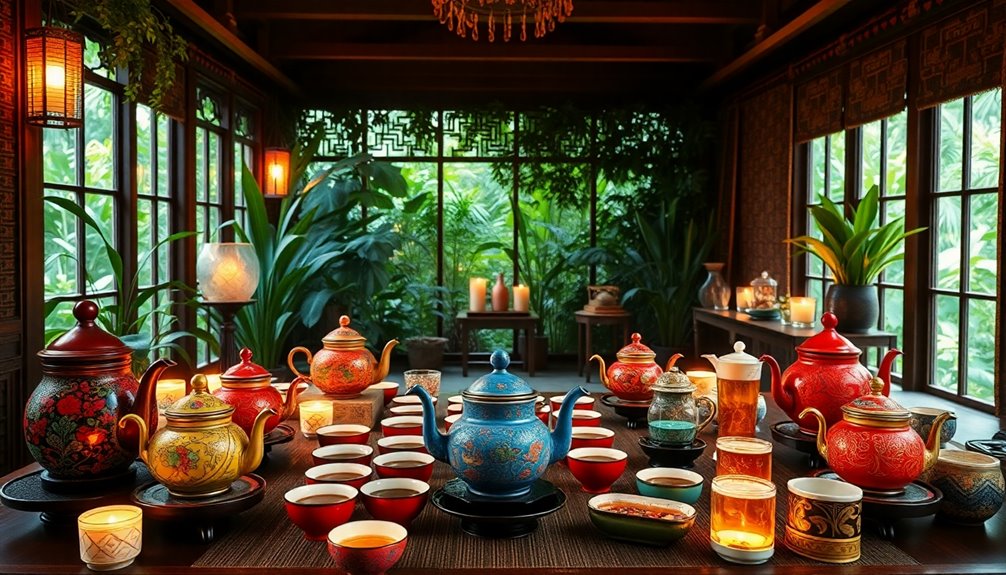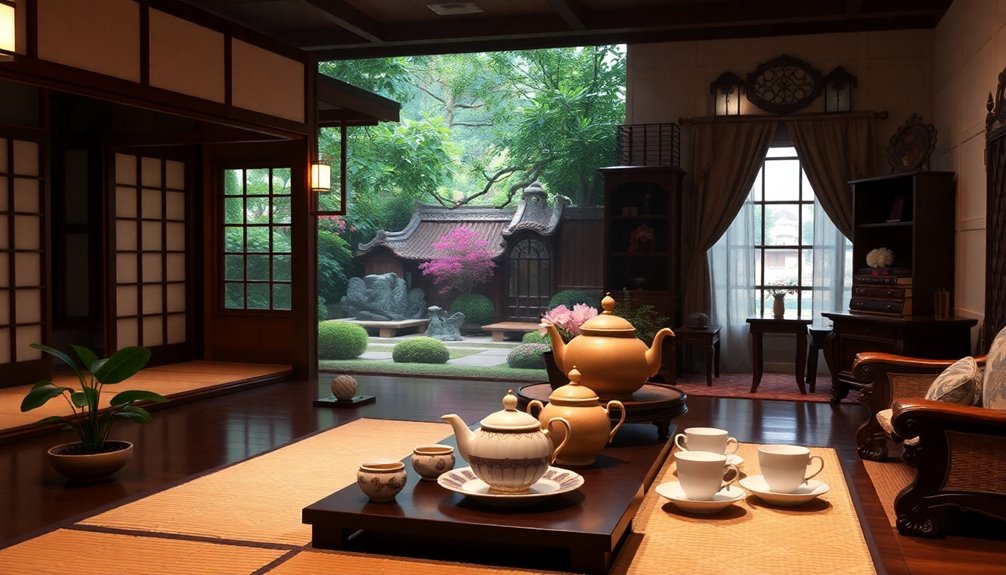Tea ceremonies are important for bringing people together and building community bonds. They create shared experiences, whether it's a Japanese tea ceremony that teaches harmony or a British afternoon tea promoting regular gatherings. You can connect with friends and family across generations during these rituals. The calming atmosphere helps resolve conflicts, allowing for thoughtful conversations. Also, engaging in tea traditions fosters a deeper understanding of different cultures. By participating in these ceremonies, you promote respect and appreciation among everyone involved. If you want to discover even more about the fascinating ways tea strengthens communities, just stick around!
Key Takeaways
- Tea ceremonies create shared experiences that foster deeper community bonds and enhance social cohesion.
- Engaging in diverse tea rituals promotes understanding and respect among different cultural backgrounds.
- Intergenerational connections are strengthened as family members share stories and traditions during tea gatherings.
- The calming atmosphere of tea ceremonies encourages open communication and conflict resolution among participants.
- Tea houses serve as communal hubs, facilitating dialogue and enhancing relationships within the community.
Introduction
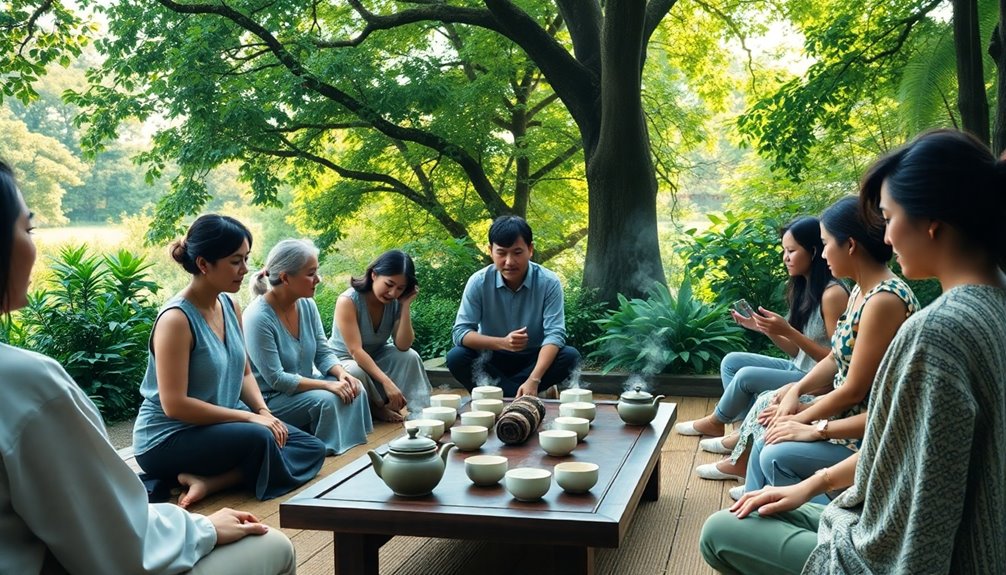
Tea ceremonies aren't just about sipping a warm beverage; they're a gateway to building community bonds. When you participate in a tea ceremony, you engage in a shared experience that fosters social interaction and connection. In a tranquil setting, the Japanese tea ceremony emphasizes cultural values like harmony and respect, especially during the ritual of serving matcha. This creates a special moment where everyone feels included.
Around the world, tea ceremonies have unique flavors. For instance, the Chinese Gongfu tea ceremony highlights hospitality and societal respect, encouraging open conversation. In Britain, afternoon tea acts as a regular social anchor, bringing friends together for predictable gatherings that strengthen relationships.
Tea houses play a vital role in this connection, serving as communal hubs where diverse groups can come together. These spaces encourage dialogue, enhancing social cohesion within communities.
Whether you're enjoying a cup of matcha in Japan or sharing stories over afternoon tea in Britain, you're part of a rich tradition that celebrates the appreciation for simplicity and the power of connection.
Cultural Exchange Through Tea Ceremonies
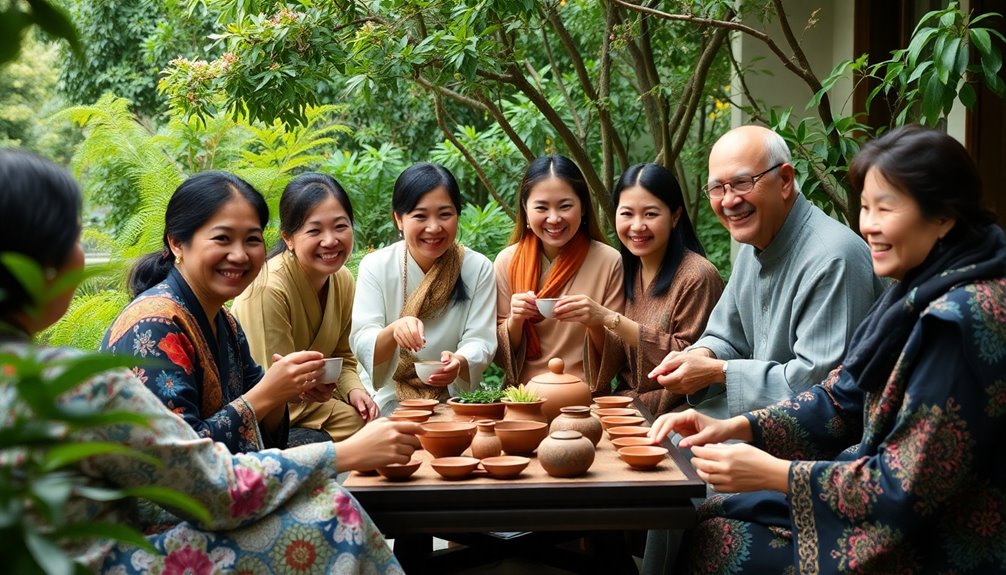
Global interest in tea culture means you can find elements from various traditions in your local community.
This blending of practices promotes understanding and respect for different backgrounds. By participating in these tea ceremonies, you not only learn about the beauty of imperfection in Japanese aesthetics but also the joy of fleeting moments spent together.
Tea Fosters Intergenerational Connections
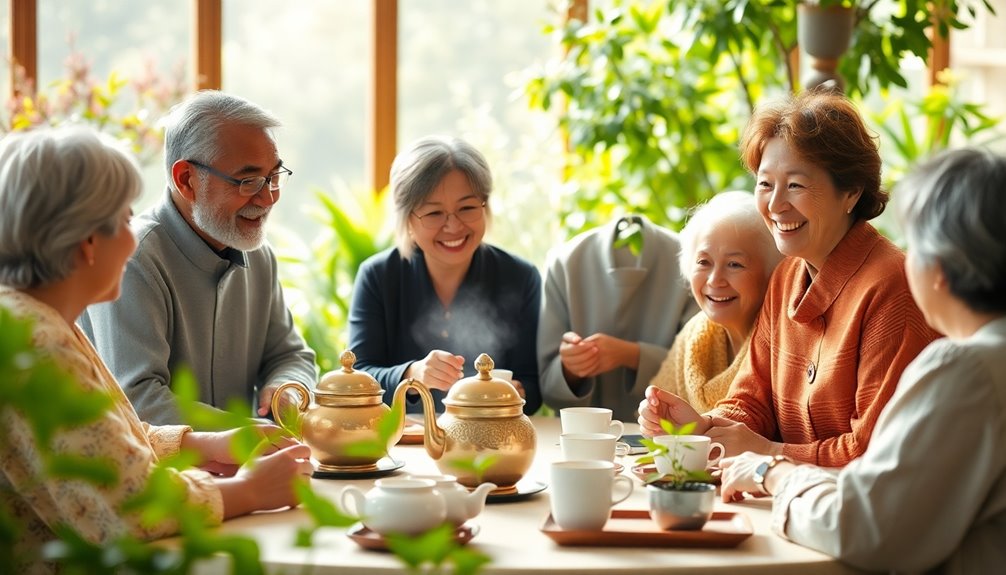
Participating in tea ceremonies not only enriches cultural understanding but also strengthens intergenerational connections. These gatherings create a wonderful platform for intergenerational engagement, where younger and older family members can share stories and wisdom. This sharing fosters mutual respect and understanding between generations.
In many cultures, such as Japan and China, the ritual of tea preparation is a cherished family tradition. As you learn the art of making tea, you're also connecting with your cultural heritage. The calming atmosphere of tea ceremonies encourages open communication, making it easier to bond over shared experiences.
By focusing on the importance of etiquette and the beauty of tea utensils, younger participants gain valuable lessons that promote continuity in family traditions. Regularly scheduled tea gatherings can enhance your community bonds, providing consistent opportunities for interaction and fun!
Whether you're pouring tea or simply enjoying a cup, these ceremonies offer a chance for everyone to connect. So, gather your family, make some tea, and enjoy the warmth of conversation that flows as freely as the tea itself.
You'll be amazed at how these moments strengthen ties across generations!
Tea as a Conflict Resolver
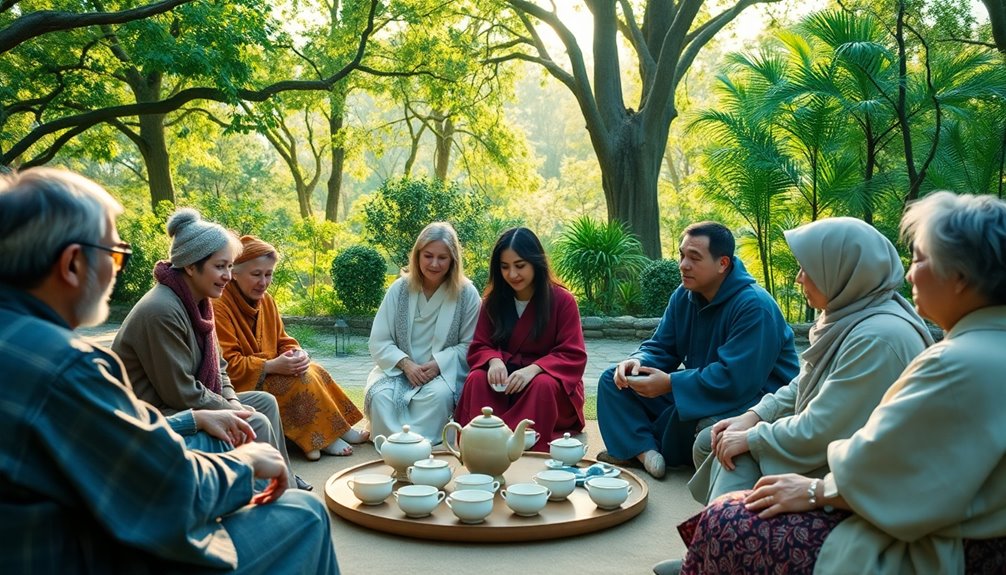
Sipping a warm cup of tea can transform tense situations into opportunities for understanding and resolution. When you engage in a tea ceremony, you create a serene environment perfect for conflict resolution. This traditional ritual encourages mindfulness, allowing everyone involved to slow down and think carefully about their words.
In the Japanese tea ceremony, participants focus on being present, which opens the door for thoughtful conversations. Similarly, the Chinese Gongfu tea ceremony emphasizes hospitality and respect, making it a safe space to discuss disagreements. As you share tea, you build deep connections, bridging cultural and social divides.
The act of tea drinking fosters community bonds, helping people from different backgrounds come together. By slowing down conversations, tea ceremonies reduce emotional tensions, encouraging understanding among those involved.
Whether you're enjoying tea in a cozy tea house or at home, remember that sharing tea is more than just a drink; it's an invitation to dialogue.
Cultural Appropriation Debates
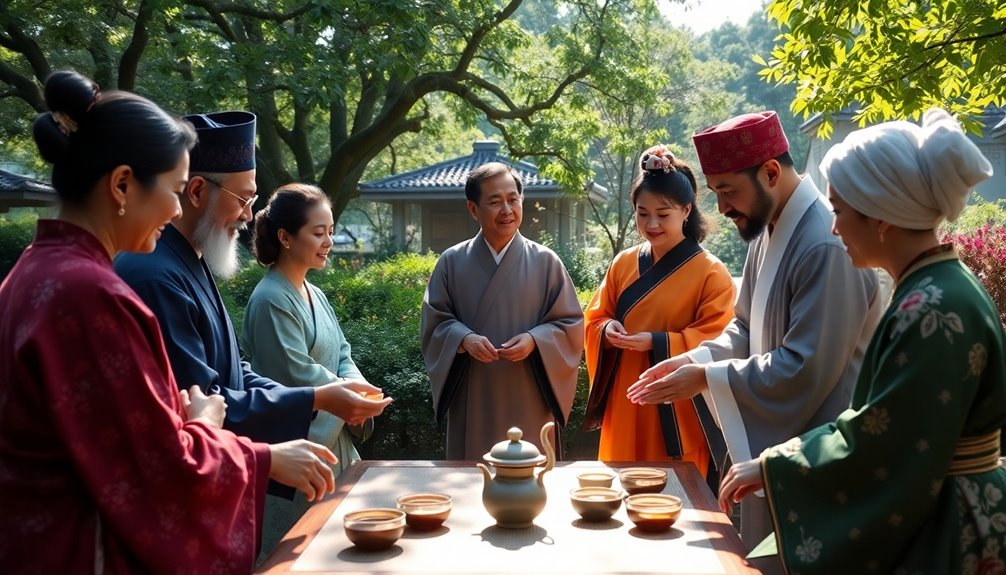
Tea ceremonies have become popular beyond their cultural origins, sparking conversations about cultural appropriation. When you practice a traditional tea ceremony, like the Japanese Chanoyu or Chinese Gongfu, it's important to understand their significance. Critics say that when these ceremonies are done without respect, they can turn into mere performances or trends, losing their true meaning.
To truly appreciate these cultural practices, you should focus on education. Learning about the rituals and histories behind traditional tea can help you engage authentically. This appreciation for the present moment encourages mutual respect between cultures.
It's not just about enjoying a cup of tea; it's about honoring the customs and values that come with it. The debate around cultural appropriation reminds us that there's a fine line between sharing and misusing these traditions. Ethical consumption is key here.
Practical Applications
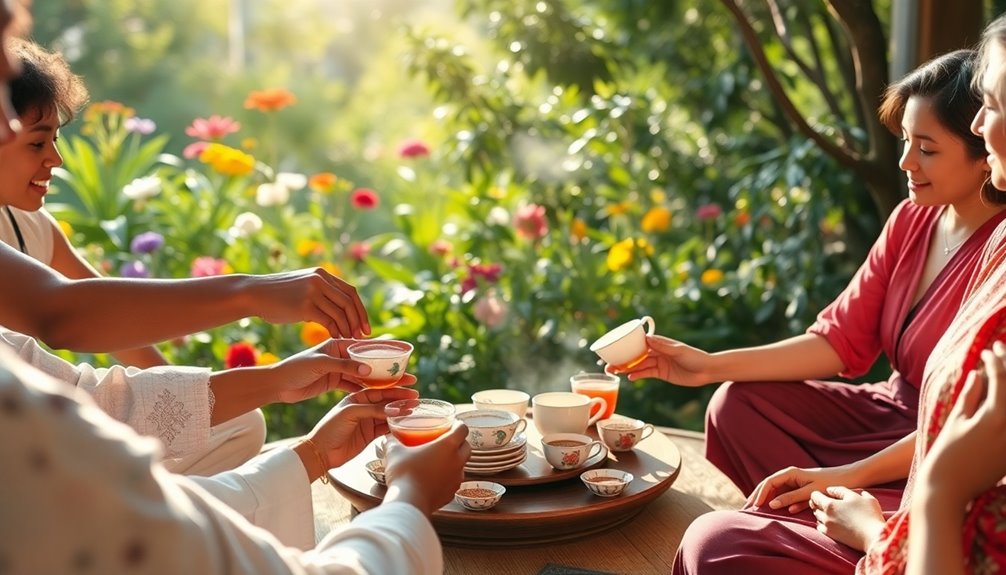
Engaging in tea ceremonies offers practical applications that strengthen community bonds and foster mindfulness. By participating in these rituals, you create shared experiences that bring people together. Whether it's the Japanese Chanoyu or British afternoon tea, these ceremonies provide a structured environment for connection and engagement.
Tea houses act as welcoming community hubs where individuals from different backgrounds gather. Here, you can enjoy conversations, participate in cultural rituals, and cultivate mutual understanding. Setting up workshops to teach traditional tea practices can deepen cultural appreciation and invite more participation. Additionally, incorporating herbal tea's anti-inflammatory properties can enhance the overall well-being of participants in these gatherings.
The calming effects of tea ceremonies also play a vital role in conflict resolution. When tensions arise, sharing a cup of tea can create a peaceful atmosphere, allowing for meaningful dialogue. You'll find that these moments of tranquility help navigate disagreements and strengthen relationships.
Incorporating tea ceremonies into community events not only enhances engagement but also fosters mindfulness among participants.
Frequently Asked Questions
What Is the Significance of the Tea Ceremony?
The tea ceremony's significance lies in its ability to foster mindfulness, respect, and harmony. You experience these values firsthand, creating meaningful connections with others while appreciating the beauty of shared moments and cultural traditions.
What Are the Four Principles of the Tea Ceremony?
You'll find the four principles of the tea ceremony are harmony, respect, purity, and tranquility. Each principle guides your actions, creating a mindful atmosphere that enhances the overall experience for everyone involved.
What Is the Main Object of the Tea Ceremony?
The main object of the tea ceremony's to prepare and serve tea, especially matcha. You focus on ritual and beauty, creating a mindful experience that encourages you to appreciate the present and enjoy shared moments.
What Is the Most Significant Thing in a Tea Ceremony?
The most significant thing in a tea ceremony is mindfulness. You focus on the moment, appreciating each unique encounter. Through careful preparation and respectful interaction, you create a shared experience that fosters connection and harmony.
Conclusion
Tea ceremonies are more than just sipping a warm drink; they're a fantastic way to bring people together! They help us share cultures, connect across generations, and even resolve conflicts. While it's important to respect the traditions behind them, you can host your own tea ceremony to strengthen bonds in your community. So, why not invite friends or family for a cozy gathering? You'll create lasting memories and deepen your connections, all while enjoying a delicious cup of tea!

